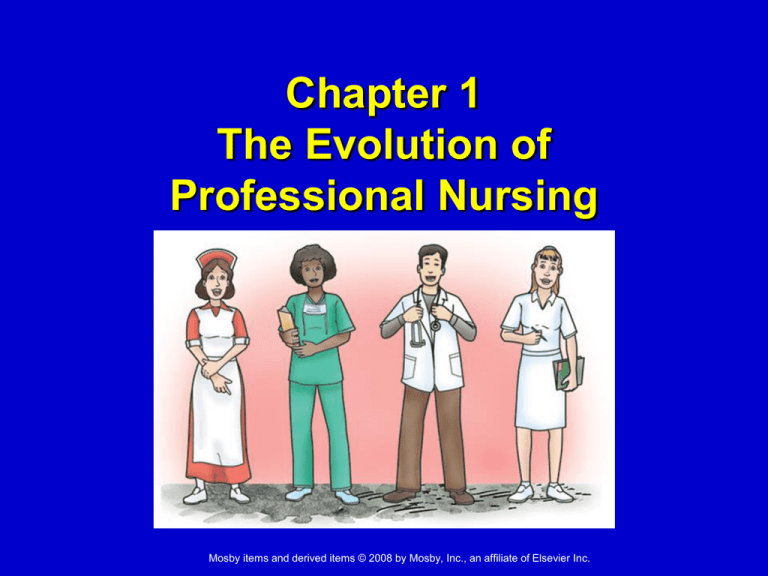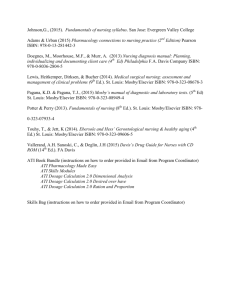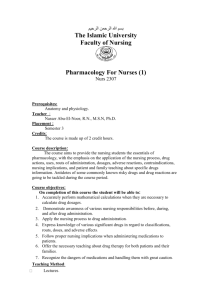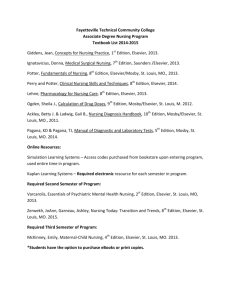Cultural Competency and Social Issues in Nursing and Health Care
advertisement

Chapter 1 The Evolution of Professional Nursing Mosby items and derived items © 2008 by Mosby, Inc., an affiliate of Elsevier Inc. Prehistoric Period Health beliefs All natural phenomena, including illnesses, were the work of the gods Health practices Engaged in acts intended to deter evil gods and demons Mosby items and derived items © 2008 by Mosby, Inc., an affiliate of Elsevier Inc. Early Civilization Egypt Health beliefs and practices • Valued personal health; preventive measures taken to appease the gods • Developed specific laws on cleanliness, food use and preservation, drinking, exercise, and sexual relations, and a pharmacopeia with more than 700 natural remedies Nursing • Little information available • Women were hired by privileged families to care for the sick and to assist with childbirth; Shiphrah and Puah were midwives who saved the baby Moses. Mosby items and derived items © 2008 by Mosby, Inc., an affiliate of Elsevier Inc. Early Civilization Palestine Health beliefs and practices • Developed the Mosaic Code, one of the first organized methods of disease control and prevention Nursing • Little information available • Nursing and medical care were provided in the home by male Hebrew priests and women (usually widows or maidens) who focused on both physical and spiritual healing and comfort. Mosby items and derived items © 2008 by Mosby, Inc., an affiliate of Elsevier Inc. Early Civilization Greece Health beliefs • Believed that the gods and goddesses of Greek mythology controlled health and illness • Temples built to honor Asclepius, the god of medicine, were designated to care for the sick. Medical science • Asclepius carried a staff intertwined with serpents, representing wisdom and immortality; staff was the model for medical Caduceus • Hippocrates is considered the “father of medicine.” • Hippocrates was the first to attribute disease to natural causes rather than supernatural causes and curses of the gods. • Scientific approach; patient-centered approach Mosby items and derived items © 2008 by Mosby, Inc., an affiliate of Elsevier Inc. Early Civilization India Health beliefs and practices • Vedas (2000-1200 BC), sacred Hindu books, were the source of information about health practices. • Focused on the use of magic, charms, herbs, and spices to cure disease and remove demons Medical science • Developed procedures to perform major and minor surgical operations • Recorded extensive information about childhood diseases, prenatal care, and conditions of the urinary and nervous systems Nursing • Hindu physicians performed major and minor surgeries, including limb amputations, cesarean deliveries, and suturing wounds • Women did not work outside the home. Mosby items and derived items © 2008 by Mosby, Inc., an affiliate of Elsevier Inc. Early Civilization China Health beliefs • Teachings of Confucius (531-479 BC) had a powerful impact on health practices. • Believed in the yin and yang philosophy; an imbalance between the two would result in ill health Health practices • Used treatments, including acupuncture, hydrotherapy, massage, and exercise, to promote health and harmony • Used drug therapy to manage disease conditions and recorded more than 1000 drugs Mosby items and derived items © 2008 by Mosby, Inc., an affiliate of Elsevier Inc. Early Civilization Rome Adapted health and medical practices from the countries conquered and the physicians enslaved (27 BC-476 AD) Established the first military hospital in Europe in Rome Mosby items and derived items © 2008 by Mosby, Inc., an affiliate of Elsevier Inc. The Renaissance and the Reformation Period Major advancements in medicine: pharmacology, chemistry, and medical knowledge “Dark ages” of nursing Religious orders became almost extinct as a result of dissension between Roman Catholic Christians and Protestant sects Nursing no longer appealed to women of high social status; hospital care was regulated to common women, prisoners, thieves, and drunks. Nursing became an undesirable job with poor pay, long hours, and strenuous work that was considered menial. Mosby items and derived items © 2008 by Mosby, Inc., an affiliate of Elsevier Inc. Middle Ages Women used herbs and new methods of healing. Men used purging, leeching, and mercury. The Roman Catholic Church became a central figure in health care. Wives of emperors and other women became nurses. Most changes in health care were based on charity and the sanctity of human life. Women cared for the sick in their homes. Mosby items and derived items © 2008 by Mosby, Inc., an affiliate of Elsevier Inc. The Renaissance and the Reformation Period Social conditions Famine, plague, filth, and crime ravaged Europe. Nursing orders were established out of great concern for social welfare. • Sisters of Charity—recruited young women for nurse training, developed educational programs, and cared for abandoned children • St. Vincent de Paul—established the Hospital for the Foundling to care for orphaned and abandoned children Mosby items and derived items © 2008 by Mosby, Inc., an affiliate of Elsevier Inc. The Colonial American Period Mexico First colonists in Mexico were members of Catholic religious orders. Hospital of the Immaculate—first hospital in North America, built in 1524 in Mexico City; first medical school, built at the University of Mexico Mosby items and derived items © 2008 by Mosby, Inc., an affiliate of Elsevier Inc. The Colonial American Period Colonial America Health care was sadly deficient; life expectancy was low; plagues such as yellow fever and smallpox were a constant threat. Physicians were poorly trained and used crude methods of treatment such as bleeding and purgatives. Through the efforts of Benjamin Franklin, Pennsylvania Hospital was the first hospital built in the United States in 1751. Mosby items and derived items © 2008 by Mosby, Inc., an affiliate of Elsevier Inc. Florence Nightingale Early nursing career Family opposed her interest in nursing at first, then she was permitted to pursue nurse training. 1851—attended a 3-month nurse training program at the Institute of Deaconesses at Kaiserwerth, Germany 1854—began training at the Harley Street Nursing Home; served as the superintendent of nurses at King’s College Hospital in London Mosby items and derived items © 2008 by Mosby, Inc., an affiliate of Elsevier Inc. Florence Nightingale Crimean War 1854—accepted an assignment to lead a group of 38 nurses who were sisters and nuns from various Catholic and Anglican orders to the Crimea to work at the Barracks Hospital in Scutari Despite deplorable conditions, the army doctors at first refused her assistance. Eventually, the doctors, in desperation, called for her help. Purchased medical supplies, food, and linen; set up a kitchen; instituted laundry services; initiated social services; spent up to 20 hours each day providing nursing care Mosby items and derived items © 2008 by Mosby, Inc., an affiliate of Elsevier Inc. Florence Nightingale Major accomplishments Demonstrated the value of aseptic techniques and infection control procedures Honored for her contributions to nursing research Demonstrated the value of political activism to affect health care reform Established the first nursing school in England Honored as the founder of professional nursing services, initiated social services, spent up to 20 hours each day providing nursing care Introduced principles of asepsis and infection control, a system for transcribing doctor’s orders, and a system to maintain patient records Kept careful statistics—documented a decrease in the death rate of soldiers from 42% to 2% as a result of health care reforms that emphasized sanitary conditions Mosby items and derived items © 2008 by Mosby, Inc., an affiliate of Elsevier Inc. Mary Seacole Jamaican nurse who played a major role in the Crimean War Was denied the opportunity to join Nightingale’s nursing brigade because she was black Opened a lodging house with her own money to care for sick and wounded soldiers Contributed to control of the cholera epidemic through extensive knowledge in tropical medicine Honored by the Jamaican government and the British Commonwealth with a medal for saving the lives of countless sick and wounded soldiers Mosby items and derived items © 2008 by Mosby, Inc., an affiliate of Elsevier Inc. Nursing in the United States The Civil War period The Civil War or the War Between the States(1861-1865) No army nurses and no organized medical corps when the war began Dorothea Dix—appointed to organize military hospitals, provide trained nurses, and disperse supplies; she received no official status and no salary for this position 6 million people hospitalized during the war—425,000 for war casualties; vast majority for disease epidemics 181 African-American nurses, both men and women, served from 1863 to 1864. Caucasian nurses made $12.00 per month; African-American nurses made $10.00 Mosby items and derived items © 2008 by Mosby, Inc., an affiliate of Elsevier Inc. Nursing in the United States African-American nurses made important contributions. • Harriet Tubman cared for wounded soldiers and conducted an “underground railroad” to lead slaves to freedom. • Sojourner Truth, known for her abolitionist efforts, as well as her nursing efforts, was an advocate of clean and sanitary conditions so patients could heal. • Susie King Taylor, although hired in the laundry, worked full time as a nurse on the battlefront with no pay or pension; not considered an official Union Army nurse Volunteer nurses who made important contributions • Clara Barton operated a war relief program; credited with founding the American Red Cross • Louisa May Alcott authored detailed accounts of the experiences encountered by nurses during the war for a newspaper publication entitled Hospital Sketches. Mosby items and derived items © 2008 by Mosby, Inc., an affiliate of Elsevier Inc. Nursing in the United States Number of nurse training schools increased after the war • Offered little classroom education • On-the-job training occurred in the hospital wards. • Students were used as supplemental hospital staff. 1890—Establishment of African-American hospitals and nursing schools gained momentum. • John D. Rockefeller established the first school of nursing for African-American women at the Atlanta Baptist Seminary, now known as Spelman College. Mosby items and derived items © 2008 by Mosby, Inc., an affiliate of Elsevier Inc. Nursing in the United States 1900 to World War I Advances in the nursing profession • By 1910, most states passed legislation requiring nurse registration before entering practice. • Required entry level for nursing students was upgraded to high school graduate. • Nurse training programs were improved to include a more comprehensive course of study. Mosby items and derived items © 2008 by Mosby, Inc., an affiliate of Elsevier Inc. Nursing in the United States Lillian Wald developed a viable practice for public health nursing (The Henry Street Settlement) located in the Lower East Side of New York City. • Purpose was to provide well baby care, health education, disease prevention, and treatment of minor illnesses. • Nursing practice at the Henry Street Settlement formed the basis for public health nursing in the United States. Developed the first nursing service for occupational health (Metropolitan Life Insurance Company) • Prevention of disease in workers to promote productivity • Sliding scale fee Mosby items and derived items © 2008 by Mosby, Inc., an affiliate of Elsevier Inc. Nursing in the United States World War I and the 1920s Advances in medical care and public health • Improved hospital care and surgical techniques • Discoveries in pharmacology—insulin and the precursor to penicillin • Environmental conditions improved; serious epidemics of the previous century became nonexistent. Mosby items and derived items © 2008 by Mosby, Inc., an affiliate of Elsevier Inc. Nursing in the United States Advances in nursing • Nurses served honorably during WWI • Nurse anesthetists made their first appearance as part of frontline surgical teams. • U.S. Public Health Service sought the assistance of a nurse to establish nursing services at military outposts. • American Red Cross, founded by Clara Barton in 1882, became more active in urban settings and rural communities. • Mary Breckenridge established the Frontier Nursing Service (FNS) in 1925 in rural Kentucky to assist disadvantaged women and children; documented the impact of nursing services on improving the health of communities; well known for midwifery services Mosby items and derived items © 2008 by Mosby, Inc., an affiliate of Elsevier Inc. Nursing in the United States Legislation • Sheppard-Towner Act—first legislation to assist special populations and provide public health nurses with resources to promote the health and well-being of women, infants, and children The Great Depression (1930-1940) Social issues • American economy was disintegrated with more than 6 million people unemployed. • Nurses also were forced to join the ranks of the unemployed. Mosby items and derived items © 2008 by Mosby, Inc., an affiliate of Elsevier Inc. Nursing in the United States Legislation • “New Deal” enacted to rescue the country and provide for medical care and other services for the large numbers of indigent people • Social Security Act of 1935 affected health care and provided avenues for public health nursing. Mosby items and derived items © 2008 by Mosby, Inc., an affiliate of Elsevier Inc. Nursing in the United States • Main purposes of the Social Security Act National age-old insurance system Federal grants to states for maternal and child welfare services Vocational rehabilitation services for the handicapped Medical care for crippled children and blind people to strengthen public health services A Federal-State unemployment system Mosby items and derived items © 2008 by Mosby, Inc., an affiliate of Elsevier Inc. Nursing in the United States World War II Legislation • Programs enacted to expand nursing education and increase the number of nurses in all military branches Advances in nursing • Nursing became an essential part of the military advance. • Nurses recognized as an integral part of the military and attained officer rank Mosby items and derived items © 2008 by Mosby, Inc., an affiliate of Elsevier Inc. Nursing in the United States Post World War II (1945-1950) Social issues • Unemployment dropped to all-time lows • Women were encouraged to return to childbearing and marriage rather than to continue employment outside the home. Advances in nursing • Demonstrated value to the armed services during the Korean War • Emerged as a true profession with minimum national standards for nursing education established Mosby items and derived items © 2008 by Mosby, Inc., an affiliate of Elsevier Inc. Nursing in the United States • By 1950, all states had adopted the State Board Test Pool. • Number of nursing baccalaureate programs grew. • Associate degree programs developed in community and junior colleges Legislation • Nurse Training Act of 1943—first instance of federal funding to support nurse training • Hill-Burton Act—provided funding to construct hospitals; created a hospital construction boom that increased the demand for professional nurses • African-American nurses were barred from membership in the ANA because of segregation laws; all barriers were dropped in the early 1960s. Mosby items and derived items © 2008 by Mosby, Inc., an affiliate of Elsevier Inc. Nursing in the United States Nursing in the 1960s Legislation had a major and lasting impact on nursing and health care. • Community Mental Health Centers Act of 1963 • Medicaid, Title XIX of the Social Security Act, 1965 • Medicare, Title XVIII of the Social Security Act, 1965 Impact of Medicare reimbursement on nursing • Hospital occupancy increased, resulting in an increased need for hospital nurses. • Nursing embraced the hospital setting as the usual practice site. • Home health movement was initiated. Mosby items and derived items © 2008 by Mosby, Inc., an affiliate of Elsevier Inc. Nursing in the United States Nursing in the 1970s Influenced by the women’s movement, nurses demanded fairer wages and better working conditions. Hospitals continued to be the focus of nursing education and practice. Nurses were instrumental in developing community programs, including hospice programs, birthing centers, and adult day care centers. Nurse practitioners began to be recognized as viable, cost-effective providers of comprehensive health services. Mosby items and derived items © 2008 by Mosby, Inc., an affiliate of Elsevier Inc. Nursing in the United States Nursing in the 1980s Types of patients needing health care changed. • Increasing numbers of homeless and indigent • Emergence of acquired immunodeficiency syndrome (AIDS) Spiraling health care costs became an issue. • Diagnosis-related group (DRGs) system for reimbursement was • • • • • instituted. Hospitals were forced to enhance efficiencies and reduce patients’ length of stay. Case management emerged as a new area of nursing specialization. Outpatient and ambulatory services grew. Enrollment in managed care plans and health maintenance organizations grew. Advanced nurse practitioners increased in popularity. Mosby items and derived items © 2008 by Mosby, Inc., an affiliate of Elsevier Inc. Nursing in the United States • Nursing practice began to move from the hospital setting to community settings. • Disease prevention and health promotion gained importance. Medical care continued to advance. • Organ transplantation • Resuscitation and support of premature infants • Medical specialties flourished. • Medical technology flourished. Inadequate funding for public health programs became an issue. Scholars suggested that nursing research needed to be focused on substantive information to guide practice. Mosby items and derived items © 2008 by Mosby, Inc., an affiliate of Elsevier Inc. Nursing in the United States Nursing in the 1990s Growing concerns about the health of the nation • Healthy People 2000 initiative • Increasing focus on health promotion and disease prevention activities Influence of the AIDS epidemic • New procedures for infection control were required. • Universal Precautions were mandated. Exposure to hazardous materials • Workplace chemicals and radioactive substances created health risks. • Employee training was instituted across all industries. Mosby items and derived items © 2008 by Mosby, Inc., an affiliate of Elsevier Inc. Nursing in the United States Managed care movement • Focus moved from acute care to prevention and primary care. • Emphasis on outpatient, ambulatory, and home services • Massive downsizing of hospital nursing staff and increase in unlicensed assistive personnel • Increasing demand for community health nurses and advanced practice nurses Changing nursing requirements for the 1990s and beyond • Focus on health risk assessments based on family and environmental issues • Focus on health promotion and disease prevention • Promote counseling and health education Mosby items and derived items © 2008 by Mosby, Inc., an affiliate of Elsevier Inc. Nursing in the United States Nursing in the 21st century Challenges facing professional nurses • Changing duties and responsibilities • Severe nursing shortage • Patient safety, accountability, and quality of care Core competencies required by professional nurses • Critical thinking • Communication • Assessment • Leadership • Technical Skills Mosby items and derived items © 2008 by Mosby, Inc., an affiliate of Elsevier Inc. Nursing in the United States Knowledge required by professional nurses • Health promotion/disease prevention • Information technology • Health systems • Public policy Consumer issues in health care • Access • Quality • Cost • Accountability Mosby items and derived items © 2008 by Mosby, Inc., an affiliate of Elsevier Inc. Nursing in the United States Changes in society • Aging population • Intercultural population • Consumer health value • Need for a well-trained work force • AACN (2004) reports 8.1% faculty vacancy rate; average age of full time faculty older than 54.3 years of age • Nurse Reinvestment Act signed into bill August 2002 to provide funds for nursing education, recruitment, and retention • 2.9 million nurses make up the largest health care profession. Mosby items and derived items © 2008 by Mosby, Inc., an affiliate of Elsevier Inc. Nursing in the United States Opportunities for professional nurses • Opportunities to increase knowledge • Evidence-based practice • United efforts to shape health care; influence policy • United efforts to address the nursing shortage Mosby items and derived items © 2008 by Mosby, Inc., an affiliate of Elsevier Inc.




